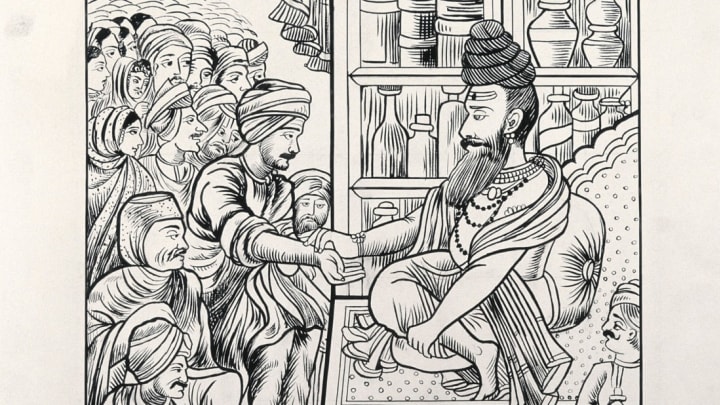If you were a petty criminal, a prisoner of war, or an adulterous woman in the ancient world, you might have had the tip of your nose cut off as a punishment [PDF]. But rather than walking around disfigured, if you had the means—and lived in ancient India—you might have had your nose reconstructed thanks to an ancient surgical method espoused by the Indian physician and surgeon Sushruta.
There's some debate around whether Sushruta was a real individual or a legendary figure. Said to have been the son of a sage who lived around 600 BCE, he's primarily known today for the classic treatise Sushruta Samhita, or Compendium of Sushruta. The treatise is considered one of the foremost achievements of Indian medicine, and went on to influence the West. Along with Charaka and Vagbhata—two other possibly legendary authors of key texts—Sushruta is honored in India as one of the "Triad of Ancients."
The Sushruta Samhita describes more than a thousand diseases (including a very early awareness of diabetes), and about 650 types of drugs. The text includes a special focus on surgery, which it considers the apex of the healing art. The roughly 300 surgical procedures it describes include cataract surgery, the removal of bladder stones, hernia repair, eye surgery, and Cesarean sections. The treatise also describes how to control bleeding, set broken bones, use wine and other drugs to anesthetize the patient, and employ large ants as wound clips (apparently, their strong mandibles can close a gash in lieu of stitches). The text also stresses the importance of cleanliness in both surgeons and their instruments—safeguards Europe wouldn’t adopt for the better part of two millennia.
But the most famous part of the text is its technique for repairing and recreating a nose, known today as reconstructive rhinoplasty. Sushruta recommended using a long, broad "leaf of a creeper" as a template for cutting a flap of skin from the cheek or forehead. After scarifying the flap with a knife, the skin was then placed over the missing nose, after which "the coolheaded physician should steadily tie it up with a bandage decent to look at," the text says. Two small pipes—reeds or tubes from the castor oil plant—were inserted into the nostrils to facilitate breathing. The nose was then dusted with medicinal powders, enveloped in cotton, and sprinkled with sesame oil.

Sushruta’s knowledge took a long time traveling west. The Sushruta Samhita was translated into Arabic around the 8th century CE, and that version may have arrived in Europe before the Renaissance; Sushruta’s techniques were apparently known to surgeons in Italy in the 1400s and 1500s. The Indian method for repairing a nose was then lost to Western medicine for a couple of hundred years, although of course Indian surgeons continued to practice it.
Then, in 1793, two British surgeons observed the procedure being carried out on a cart driver who had been taken prisoner by a sultan in the Third Anglo-Mysore war, and an acquaintance of theirs published an account of the surgery in London's Gentleman's Magazine the following year. A British surgeon named Joseph Constantine Carpue read about the procedure, and practiced it on cadavers for 20 years before performing the operation (successfully) on a patient in 1814. His subsequent publication popularized the procedure in Europe, and by the 1830s the technique had made it to the United States.
Sushruta is widely honored in India today. The country boasts several statues of him, and his image is on the seal of the Association of Plastic Surgeons of India. A version of his procedure, often called the Indian method, is still one of the preferred ways of repairing noses around the world.
